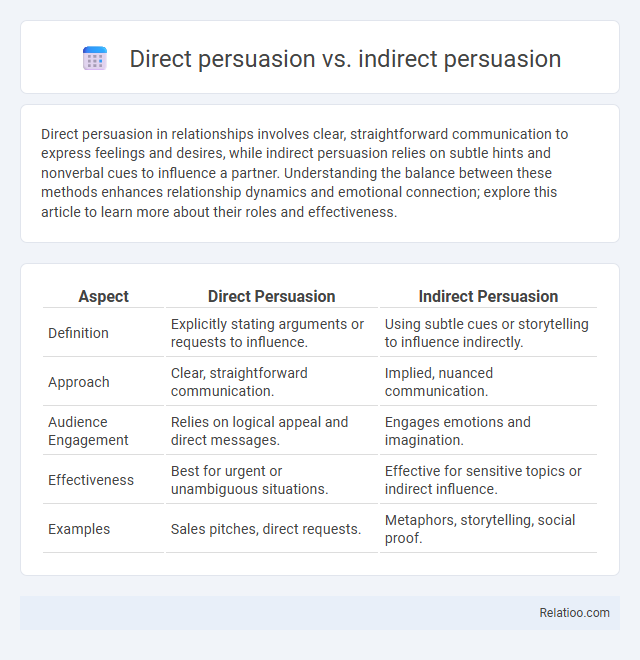Direct persuasion in relationships involves clear, straightforward communication to express feelings and desires, while indirect persuasion relies on subtle hints and nonverbal cues to influence a partner. Understanding the balance between these methods enhances relationship dynamics and emotional connection; explore this article to learn more about their roles and effectiveness.
Table of Comparison
| Aspect | Direct Persuasion | Indirect Persuasion |
|---|---|---|
| Definition | Explicitly stating arguments or requests to influence. | Using subtle cues or storytelling to influence indirectly. |
| Approach | Clear, straightforward communication. | Implied, nuanced communication. |
| Audience Engagement | Relies on logical appeal and direct messages. | Engages emotions and imagination. |
| Effectiveness | Best for urgent or unambiguous situations. | Effective for sensitive topics or indirect influence. |
| Examples | Sales pitches, direct requests. | Metaphors, storytelling, social proof. |
Understanding Direct Persuasion
Direct persuasion involves clear, straightforward messaging designed to influence Your decisions quickly and effectively by presenting explicit reasons or benefits. This approach contrasts with indirect persuasion, which relies on subtle cues, storytelling, or emotional appeals to shape attitudes without overtly stating the intent. Understanding direct persuasion enables better identification of persuasive strategies in marketing, negotiation, and communication by focusing on transparent and concise arguments.
What Is Indirect Persuasion?
Indirect persuasion involves subtly influencing someone's attitude or behavior without overt pressure or direct requests, often by appealing to emotions, storytelling, or social proof. Unlike direct persuasion, which straightforwardly presents arguments or demands, indirect persuasion relies on implicit cues and context to guide your decisions. This approach enhances receptiveness by fostering trust and reducing resistance, making it a powerful tool in marketing, negotiation, and interpersonal communication.
Key Differences Between Direct and Indirect Persuasion
Direct persuasion involves explicitly presenting arguments or requests to influence Your decisions, relying on clear, straightforward communication. Indirect persuasion employs subtle cues, storytelling, or emotional appeals to guide Your thinking without overtly stating the intent. The key difference lies in direct persuasion's transparent approach versus indirect persuasion's covert techniques to impact attitudes and behavior.
When to Use Direct Persuasion
Direct persuasion is most effective when your audience is already somewhat interested or familiar with your message, allowing clear and straightforward appeals to drive action. Use direct persuasion for urgent calls to action, decisive situations, or when addressing a rational, goal-oriented audience who values clarity and transparency. Your communication succeeds by presenting strong evidence and explicit benefits that align with the listener's immediate needs and preferences.
Situations Ideal for Indirect Persuasion
Indirect persuasion thrives in situations where resistance may be high or when building rapport is crucial, such as in sensitive negotiations or cross-cultural communications. Your approach can gently influence opinions by embedding suggestions within stories, questions, or subtle cues. This method often leads to more sustainable attitude changes by reducing defensiveness and increasing openness.
Psychological Effects of Direct Persuasion
Direct persuasion employs clear, explicit messages intended to influence attitudes or behavior, often triggering immediate cognitive processing and emotional responses. This approach can lead to heightened awareness and quick decision-making but may also cause resistance or reactance if perceived as too forceful. In contrast, indirect persuasion relies on subtle cues or implicit suggestions, engaging subconscious processing and reducing defensive reactions, while general persuasion encompasses both strategies to shape beliefs and actions effectively.
The Impact of Indirect Persuasion on Decision-Making
Indirect persuasion subtly influences decision-making by engaging emotions and implicit cues, leading individuals to make choices without overt pressure. This method leverages storytelling, social proof, and framing effects to shape perceptions and attitudes, enhancing receptivity and long-term attitude change. Unlike direct persuasion, indirect techniques reduce resistance and cognitive dissonance, resulting in more sustained behavioral outcomes.
Cultural Preferences in Persuasion Styles
Direct persuasion relies on explicit, clear messages favored in low-context cultures such as the United States and Germany, where straightforwardness is valued. Indirect persuasion is common in high-context cultures like Japan and China, emphasizing subtlety, harmony, and non-verbal cues to influence others. Understanding cultural preferences in persuasion styles enhances communication effectiveness by aligning the approach with culturally ingrained expectations and social norms.
Common Pitfalls in Direct and Indirect Persuasion
Common pitfalls in direct persuasion include pushing messages too aggressively, leading to audience resistance and skepticism, while indirect persuasion often suffers from ambiguity, causing the message to be misunderstood or overlooked. Both methods risk failing when they do not align with the audience's values or needs, resulting in ineffective communication. Understanding audience psychology and tailoring the approach accordingly is crucial to avoid these common errors in persuasive communication.
Choosing the Right Persuasion Technique for Effective Communication
Direct persuasion employs clear, straightforward messages to influence your audience quickly, ideal for situations requiring immediate decisions. Indirect persuasion uses subtle cues, storytelling, and emotional appeals, effective in building trust and long-term relationships. Choosing the right persuasion technique depends on your communication goals, audience receptivity, and context to maximize impact and achieve desired outcomes.

Infographic: Direct Persuasion vs Indirect Persuasion
 relatioo.com
relatioo.com